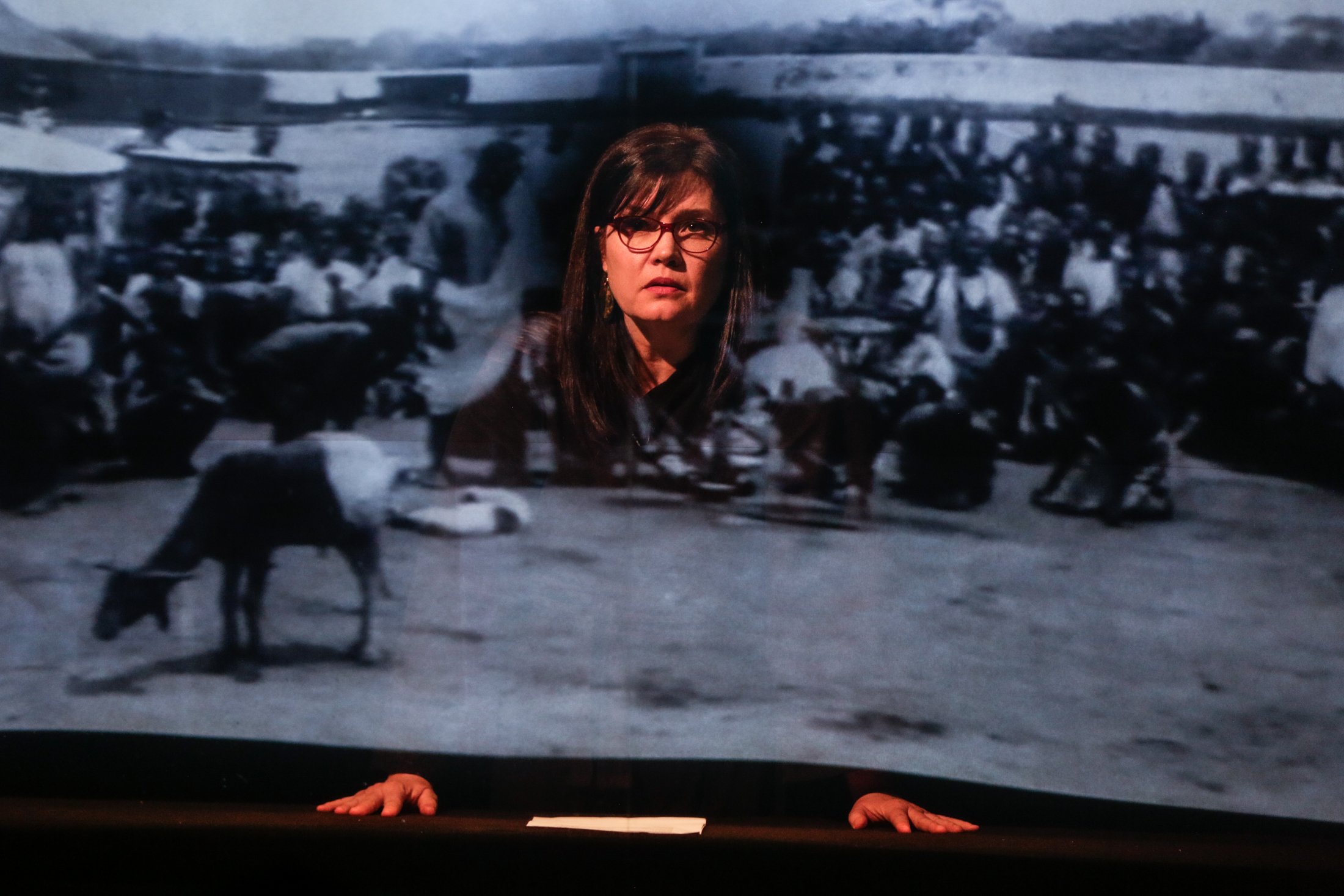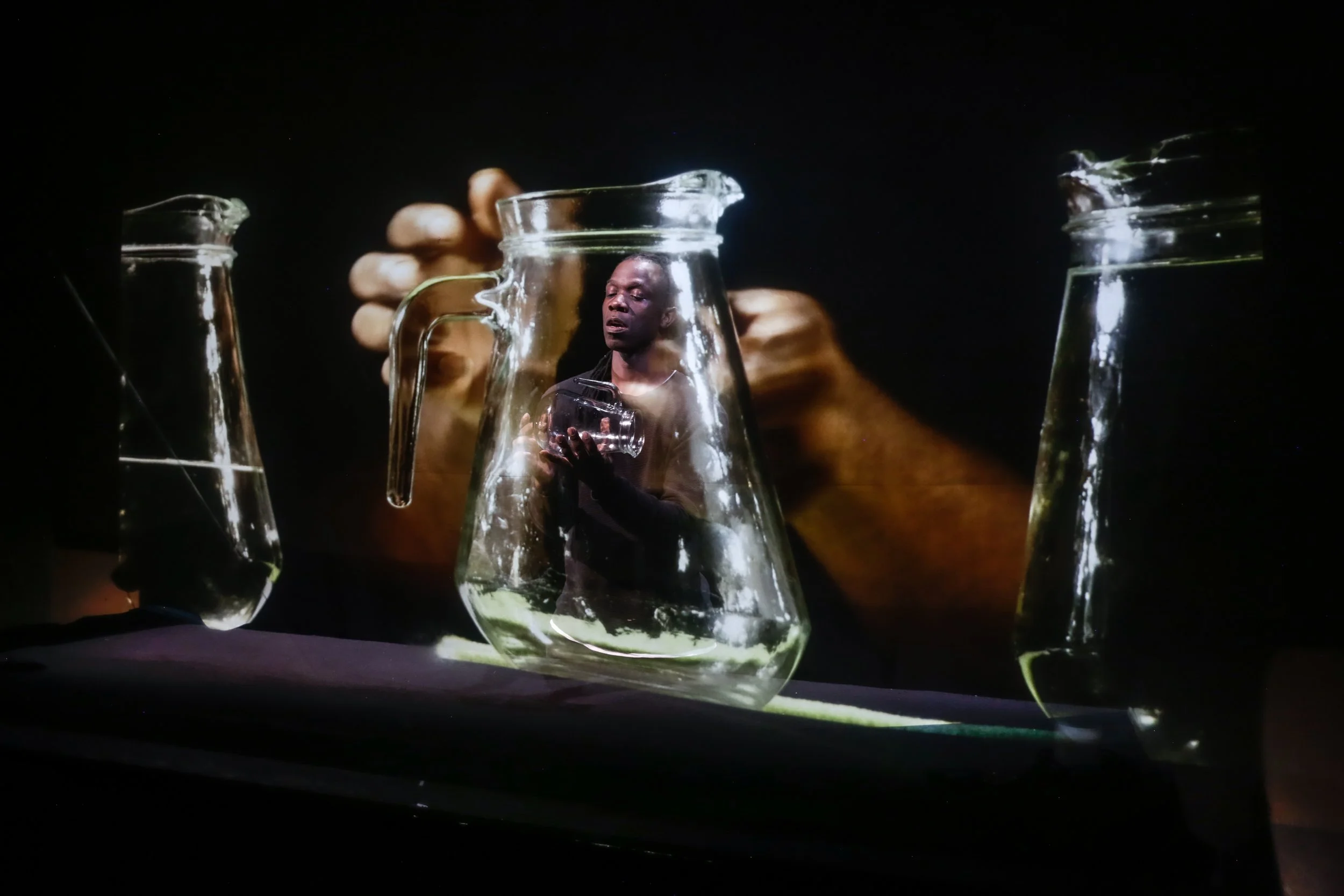“It’s about reconstituting these elements from the states in which they are held, which is often in museum collections and in archives, and bringing them into a direct relationship with the body – with breath, with movement – and into a real conversation in which we’re able to invoke the image back to life.” – Bronwyn Lace
A figure enters an image and begins to converse with what they find there. It is a puzzling scene at first, then it is intriguing, entertaining. Though the image remains static, its contents – the people, the buildings, landscapes, and fixed expressions it holds – are activated through the presence of the performer, and their engagement with the scene. Here, in the liminal realm of the Pepper’s Ghost, the scene is newly animated, and the archive begins to speak.
On 12 May 2023, SO | The Academy for the Less Good Idea hosted HOW | Showing The Making: The Pepper’s Ghost with Bronwyn Lace & Bongile Gorata Lecoge-Zulu. Taking place at The Centre for the Less Good Idea’s 2nd Space, this event unpacked the mechanism of the Pepper’s Ghost device, looking particularly at how it has been re-imagined digitally, but also inviting an audience to witness the process in which the new Pepper’s Ghost works for The Centre’s 10th Season are created. Through this HOW, Lace and Lecoge-Zulu shared their insights about the device as a potent tool for engaging and dialoguing with archival material.
Activating the archive and reading with empathy
First explored at The Centre in Season 7, the Pepper’s Ghost is a 19th-century theatrical illusion technique that uses a half-silvered mirror. The technique allows things to be seen both behind and in front of the mirror through the use of lighting and live performance. With the introduction of video compositing and live projection, new performative and narrative techniques become possible.
This much is explained by Lecoge-Zulu in a playful and succinct introductory engagement with the Pepper’s Ghost, demonstrating the device’s potential as a hybrid analogue and digital theatrical device.
Following this is Lace’s short performance lecture in which she provides insights into the potential for the device to act as a very particular kind of tool for invoking and activating archival materials. The archive being referred to by Lace is one that The Centre has been working with since 2022. Made in Dahomey (now Benin) in 1930, the images and videographic footage are drawn from the Archives of the Planet, funded by French banker and philanthropist Albert Kahn (1860-1940), and now housed in the Musée départemental Albert-Kahn in Paris.
Much of this archive contains videographic and photographic material that has not been seen publicly, and that depicts customs, rituals and traditions that are simultaneously performative and sacred. The challenge and the invitation when engaging this archive through the kind of experimental, collaborative performance and ways of seeing necessitated by the Pepper’s Ghost, explains Lace, is to approach the archive with an equal amount of risk, respect, and empathy.
A device that leans into other worlds
Following these introductions to the device, three individual engagements and an ensemble moment are presented, all of them process works from a recent workshop towards The Centre’s 10th Season. The engagements are brief and experimental, each one demonstrating the potential of the Pepper’s Ghost to serve as a device for the distortion and evocation of time and memory.
In Anathi Conjwa’s engagement with the Pepper’s Ghost, a short filmed segment depicting a group of people sitting outside of a structure, facing away from the camera, is projected on a loop. Conjwa steps into a gap in the image and suddenly forms part of the group in the film. Beside her, a figure taps away at a small block, the endless percussion being produced live in the room by percussionist Micca Manganye. There are voices, too (also emerging from a chorus of performers in the room) and Conjwa proceeds to interpret them, translating and mistranslating, stopping and starting, craning her neck and closing her eyes as she listens to the figures in the frame.
Conjwa’s performance reveals the deep frustration that often accompanies an attempt at reading history, while also displaying the unique way in which the body can be inserted into the archive — the researcher’s ability to enter the image and be in conversation with history – through The Centre’s methodology of performance and play within the Pepper’s Ghost.
Similarly, Katlego Letsholonyane’s performance is a simple, yet effective demonstration of the visual nature of the device. Engaging with a single image of a landscape, Letsholonyane begins to search the image, conversing with it all the while. The presence of the shadow becomes a tool for revealing the image, and as Letsholonyane moves through the image, he reveals the figures of those behind the mirror, remaining mute, but ever-present. Thematically, the performance is about searching for oneself, one’s history, and one’s ancestry in the archives, but it is through the presence of the body, the voice, and the spectral nature of the half-silvered mirror, that the image and the impetus for Letsholonyana’s performance can be distorted, destabilised, reimagined and further explored.
In Dikeledi Modubu’s performance, a static image of a kneeling woman slowly comes into the frame. Modubu greets her with a similar gesture, kneeling before her after clapping once, twice, three times to invoke the image and the spirit alike. Here the performance is a conversation with an image, and a person, through the shifting states of time and memory as they are shaped by the Pepper’s Ghost. When Hlengiwe Lushaba-Madlala enters the image from behind the mirror, the dynamic shifts and the figure in the image is provided with a way to speak back to Modubu. Importantly, Modubu’s performance demonstrates the potential to reveal something about the character or the condition of a person one encounters in the archives, through the simple act of having a conversation with them, and subsequently locating them in a contemporary setting.
Collaborative and experimental performance
The ensemble moment is the only performance that doesn’t make use of an archival image. Instead, a filmed clip of a spinning chair is used as a provocation. Here, Vusi Mdoyi begins to echo what he sees, spinning his own chair on the floor beneath the suspended mirror, adding another image, another layer of performance to the scene. He is joined by the rest of the ensemble, each performer adding a new movement, sound or gesture to the collective image.
As the performance swells, physically and musically, the screen grows full. The floor is activated, the darkened area behind the mirror is activated, and soon there is projection, live music and physical performance all at once in the small mirror-turned-stage.
This collective, collaborative and free-spirited improvisation is one of The Centre’s primary methodologies towards the generation of new creative work. Here, it becomes a way of testing the possibilities of the device, and providing new ways of engaging and dialoguing with archival material.
– David Mann
PHOTOGRAPHER | Zivanai Matangi
CREDITS:
CURATORS | Bronwyn Lace & Bongile Gorata Lecoge-Zulu
PERFORMERS | Anathi Conjwa, Dikeledi Modubu, Katlego Letsholonyane, Vusi Mdoyi, Teresa Phuti Mojela, Hlengiwe Lushaba-Madlala, Sello Ramolahloane & Micca Manganye
A special thanks to Dr Anna Seiderer of Université Paris 8 and all involved in the project Moving Pictures, Controversial Memories (CINEMAF), an ongoing collaborative project of which The Centre for the Less Good Idea is part.
CINEMAF is an undertaking of interdisciplinary analysis (ethnology, cinema studies, history of representations and fine arts) in collaboration with heritage partners (Quai Branly Museum, Albert-Kahn Museum and the French Cinema Archives) on issues to do with analysis, remediation, and reuse of cinema materials developed in controversial historical context (colonisation in particular).
Collaborating institutions in CINEMAF:
Nanterre University, Paris
Department of Image arts and contemporary art – Paris 8 University
African Worlds Institute, Paris
University of Abomey-Calavi, Benin
Francophone Regional Center for Advanced Research in Social Sciences, University of Bucharest





